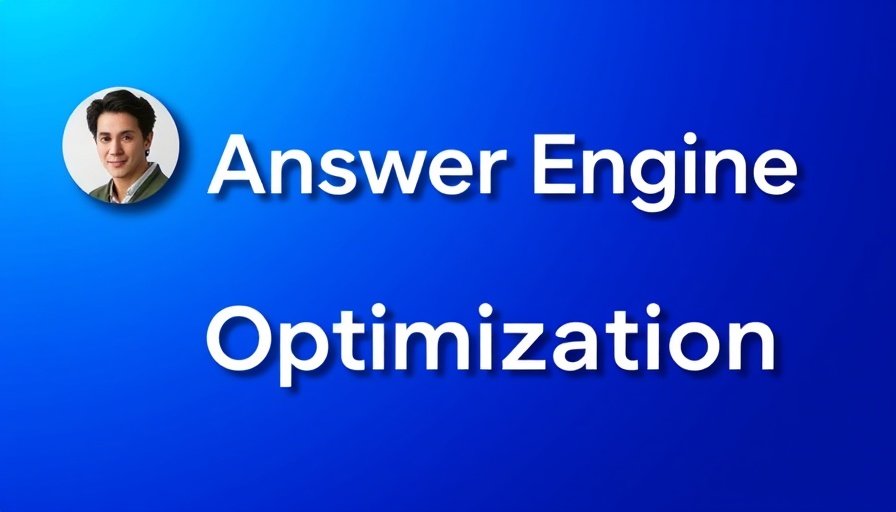
Understanding the Shift to Answer Engine Optimization in a Digital World
As the landscape of online search shifts dramatically, traditional methods of searching are rapidly evolving. Gone are the days when users would simply enter queries into a search engine and browse through pages of results. Today, people are increasingly turning to AI-powered systems for swift answers. This emerging trend has birthed the concept of Answer Engine Optimization (AEO), a strategy that builds on the principles of traditional SEO but with a vital twist—focusing on how content is presented in direct AI responses.
The Rise of AI-Powered Answers and AEO
AEO seeks to ensure that your brand and content are not just visible in organic search results but are trusted enough to be mentioned directly by AI systems. While traditional SEO revolves around getting your web pages ranked, AEO shines a spotlight on how information is directly cited in AI responses.
This method is incredibly vital for small and medium-sized businesses aiming to establish trust and credibility in AI-optimized search environments. For example, a local café might benefit immensely from being featured in an AI system's overview of “best places for coffee” without a user needing to click on any links. The emphasis on zero-click answers has never been stronger, and being part of this trend is critical for survival in the digital age.
How to Transition from SEO to AEO
Transitioning to AEO involves refining your content to be more concise and declarative. AI systems thrive on clear, structured data. For instance, small businesses can enhance their chances of being mentioned by defining their unique selling propositions succinctly—crafted in a way that AI can easily digest.
- Schema Markup and Clean Datasets: Utilizing FAQ schema or structured data can allow AI engines to extract relevant information more efficiently.
- Content Quality: Focus on producing precise answers to common queries related to your industry. This approach increases trust and enhances the likelihood of being featured.
- Engage Users Directly: As users often seek immediate answers, answer fleet-footed questions that directly address their needs.
Through these steps, businesses can not only align with the new optimization strategies but prepare for a future where AI takes center stage in search processes.
Empowering Your Brand with Trustworthiness
In an era where consumers are bombarded with information, brand trust has never been more crucial. Gaining trust involves being transparent about your offerings and engaging with customers consistently. Creating helpful content that answers their questions positions your brand as a reliable source.
A survey revealed that over 80% of consumers prefer brands that provide easily accessible information. Thus, building trust through concise AEO practices could be pivotal for the success of small and medium-sized businesses looking to make a mark in AI-driven search results.
Consequences of Ignoring AEO
Neglecting AEO could mean that small businesses miss out on significant traffic that could be captured through AI systems. As search technology keeps evolving, brands who solely focus on rankings may find themselves left behind. The dual focus on SEO and AEO ensures comprehensive visibility across both traditional and modern search platforms.
For instance, a local service provider that optimizes for both might appear in a voice search result on Google Assistant, and that can lead to increased foot traffic and inquiries.
Future Trends: Preparing for AI's Next Stage
Looking ahead, the integration of AEO into standard practice appears unavoidable. Specialists predict that AI will continue refining how information is presented to users, driving businesses to adapt at a comparable pace.
One emerging trend is the potential for AI to personalize responses, catering answers based on user behavior and preferences. Understanding how to align AEO with broader marketing strategies could be a game-changer for brands seeking to maintain relevance and competitiveness.
Conclusion: Make Generating Trust Your New Strategy
With the right strategies, AEO can seamlessly integrate into your overall marketing efforts, effectively bridging the transition from traditional methods to AI-driven solutions. Brands will need to step up by being part of the conversation in AI-generated answers rather than merely being visible in search rankings. Consider this your invitation to continue evolving with the digital age.
Now is the time for small and medium businesses to harness the power of AEO and ensure their place in a future ruled by quick, responsive search capabilities.
 Add Row
Add Row  Add
Add 



Write A Comment